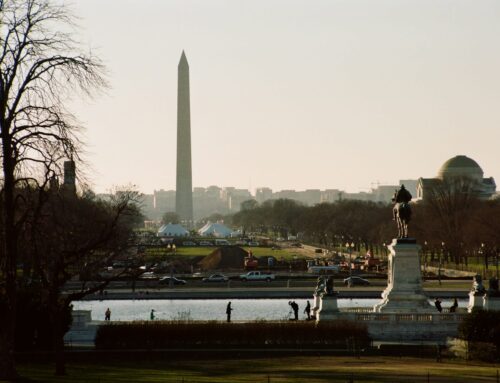Good morning Chairman Bingaman, Ranking Member Domenici, members of the Committee. Thank you for the opportunity to testify before you this morning on reform of the Mining Law of 1872. My name is Ryan Alexander and I am President of Taxpayers for Common Sense, a national non-partisan budget watchdog group.
Since its inception in 1995, TCS has advocated reform of the General Mining Law of 1872 for one simple reason: this anachronistic law is a clear example of taxpayer injustice. Public lands are taxpayer assets, and should be managed in a way that preserves their value, ensures a fair return from private interests using them for profit, and avoids future liability.
Unfortunately, the system of “management” set out in the 1872 law has allowed public lands and valuable public assets to be exploited for private profit at the expense of taxpayers. There are three primary ongoing injuries to taxpayers under the 1872 law that must be addressed by any meaningful reform effort: the giveaway of federal lands; the extraction of federal mineral assets without taxpayer compensation; and the creation of taxpayer liability by allowing the abandonment of contaminated mine lands.
Under the 1872 Mining law billions of dollars of gold, uranium, silver, and copper are taken from public lands by mining interests each year. Unlike other extractive industries, companies that mine for gold, silver, copper, uranium and other precious metals do not have to pay a fee when operating on federal land, essentially allowing these valuable minerals to be given away for free. In contrast, the oil, gas and coal industries pay more than a 12% royalty, and they and the hardrock mining companies may pay even more when mining on private, state or tribal lands.
The law also allows the sale of federal lands at 19th century prices. Under the law, federal lands are sold for no more than $5 an acre–considerably below today’s market value. Not only have mining companies been able to gain title to land valued at tens of millions of dollars for as little as tens of thousands of dollars, but the land can be developed for other purposes, including commercial enterprises, such as condominiums, ski resorts and casinos.
The 1872 law also saddles taxpayers with the hefty clean-up costs of the toxic aftermath of mining operations. Not only do American taxpayers underwrite the profits, but they are also forced to pay for the damages left behind. These damages have been estimated to cost upwards of $50 billion.
Giveaway of Federal Land
Under the Mining Law of 1872, a claimant can “patent” or purchase a mining claim for either $2.50 or $5.00 per acre – the public is prohibited from charging market value for land subject to a claim. Just to put that in perspective, the 2006 purchasing power of $2.50 from 1872 is just 15 cents, $5.00 is 31 cents. That’s how little we are valuing taxpayer’s property. Staking a claim on federal land simply requires an annual maintenance fee of $125 per acre plus an additional $30 location fee and $15 new mining claim service fee for first timers.
A couple examples of taxpayers getting soaked by patenting:
- In Crested Butte, Colorado the federal government sold 155 acres to the Phelps Dodge mining company for approximately $790, despite a company estimate that the land could produce up to $158 million in after-tax profits over 11 years. This is in an area where land prices range as high as $1 million per acre.
- In Nevada, in 1994, American Barrick paid $9,765 for 1,950 acres that contained an estimated $10 billion in gold.
In some cases, it appears that mining patents have been little more than a ruse for developers to get their hands on valuable federal property before flipping it for other, more lucrative uses. A few examples:
- In 1983, the Forest Service sold 160 acres near the Keystone, CO ski resort for $400. Six years later the land sold for $1 million.
- In 1970, a businessman bought 61 acres in Arizona for $153. Just ten years later he sold it to a developer for $400,000, plus a share of future profits
In FY1995, Congress began enacting one-year patent moratoriums. Patent applications that were in the pipeline have been grandfathered, but new patents have not been issued since then. However, continuing the decade-long practice of one-year extensions makes little sense for the mining industry or taxpayers.
We urge the Senate to permanently end the patenting of federal land. The Congressional Research Service points out a critical fact: ending the practice of patenting “will not stop the production of valuable mineral resources from the public lands, but will prevent the further transfer of ownership of public lands to the private sector.” Transfer of public lands to the private sector at bargain basement prices should be stopped permanently.
Gold and Other Valuable Minerals for Free
After charging a pittance for the land, the Mining Law of 1872 gives private interests valuable minerals for free. Despite the private sector extracting public assets from the ground, taxpayers receive no compensation whatsoever. Since enactment of the 1872 law, the total value of minerals that have been taken without compensation is an estimated $245 billion.
By comparison, the oil and gas industry generally pays 12.5 percent in royalties on what they extract from onshore federal lands. Private landowners and states also routinely require payment for mining on their lands. Taxpayers for Common Sense would like to see Congress pass a 12.5% gross income royalty, commensurate with other extractive industries.
A gross income or net smelter return is essentially the gross income for the mineral product that the mine receives from a refinery or smelter. This ensures that the royalty automatically adjusts to changes in the market and does not over- or undercharge. TCS is aware of other proposals such as net revenue or net profits royalty, but we believe these offer too much opportunity for gamesmanship on what the deductible costs will be. A royalty based on net smelter or gross income will be the easiest system to administer for the federal government and will require the least complex enforcement systems. In a recent report the World Bank recently found more than 68% of the countries imposing a royalty use the gross income or net-smelter system.
Mineral Business Appraisal, geologic and mining experts in the appraisal of all types of mineral property, describe net profits royalty, noting “[t]here are virtually no buyers for this type of royalty because of the creative accounting that the mining operator can use to depress the royalty payment amount. The distinguishing feature of a net profits royalty is that, depending upon the exact definitions in the mining lease and the actual calculations, it will very often be zero.”
The state of Alaska provides a glaring example of how big a loss a net-proceeds royalty would be for US taxpayers. The state imposes a 3% net-proceeds royalty on mining operations on state lands. Over the last ten years Alaska has collected only $1.2 million in royalties despite the extraction of more than $1.2 billion worth of gold from state lands. According to these figures provided by the Alaska Department of Natural Resources, Alaska has imposed a less than one/tenth of one percent royalty on mining operations. Clearly, this type of royalty would continue the federal government’s massive giveaway.
According to Mineral Business Appraisal, net smelter “royalty payments are also fairly simple to calculate and administer in that only the selling price and quantity of mineral product produced or sold are required for their determination.” In addition, “this type of royalty will usually have the highest market value of all the royalty types.” Simple, predictable, and valuable – that is the way to calculate royalties in the best interest of the taxpayer.
High Costs of Clean-Up
Finally, failure to reform the General Mining Law of 1872 will leave taxpayers with a huge and growing liability for toxic waste and water contamination left behind by abandoned mines. Too often, after all the minerals have been removed, mining operations cease, move their jobs out of town to another – often related—mining operator, and leave communities with a mess and taxpayers holding the bag to pay for clean up. A 2004 report by the U.S. Environmental Protection Agency (EPA) Inspector General indicated that the Superfund National Priority List contained 63 hardrock mining sites and another nearly 100 sites could be added in the future. The price tag for cleaning up all of these sites was $7 – $24 billion, with more than half of that amount likely to be stuck on taxpayers. Because clean-up takes such a long time, it is likely that some of the businesses currently on the hook will no longer remain viable and the taxpayer’s share of clean-up will increase.
The potential unfunded liability from hardrock mining sites is even larger. A 2004 report by the EPA put the cost of remediation of hard rock mines at $20 – $54 billion. Although regulations for bonding were tightened with Section 3809 rules, they are still too weak to adequately protect taxpayers. According to a June 2005 report by the Government Accountability Office (GAO), the Bureau of Land Management (BLM) indicated that 48 hardrock operations on BLM land had ceased without reclamation since the agency began requesting some form of financial assurances in 1981. BLM estimated the costs of reclaiming 43 sites at $136 million, which the GAO says is a low-ball estimate.
To address these unfunded liabilities, TCS asks the Senate to require financial assurance and operation plans, and restrict mining in areas where the risk of an expensive clean-up is too great. Moreover, we urge the Senate to consider legislation that would enable a portion of the revenue generated by mining fees and royalties to be deposited in the General Treasury, once liabilities at the time of enactment have been discharged. Mining fees and royalties collected should also be directed towards the highest priority clean-up sites: ones with the greatest public safety concerns or highest risks for further environmental damage, rather than directed to states with the largest current production.
Over the years, the Department of Interior has had to be prodded repeatedly to require adequate financial assurances in the form of surety bonds and other tangible assets. Clearly, further legislation to ensure taxpayers are not stuck with the tab for cleaning up mining messes is required.
Other Considerations
In addition to not paying a royalty for the valuable resources they extract from public lands, hardrock mining companies enjoy preferential tax treatment that other industries do not receive. They are allowed to expense certain costs for exploration and development; they receive a depletion allowance, which is a fixed percentage deduction against gross income; and, they are allowed to deduct the costs of closing a mine and the associated reclamation costs before a mine is actually closed.
Because of the way the depletion allowance is applied, mining companies may actually receive more in deduction credits than their investment in the mine. And the combination of tax preferences and other more standard deductions available to them means that mining companies often pay an effective tax rate much lower than the statutory corporate rate of 30 percent.
Taxpayers for Common Sense also supports the end of the percentage depletion allowance tax break for the mining industry. We support the Elimination of Double Subsidies for Hardrock Mining Industry Act of 2007 introduced by Senators Feingold and Cantwell and urge the committee to include this in their larger mining reform legislation.
Progress Towards Reform
Taxpayers for Common Sense believes there are many lessons to be learned from the recent efforts towards reform of the 1872 General Mining Law. We were pleased to see the inclusion of a royalty on all mines in the recently passed reform bill in the House of Representatives. As a means to ease the transition, H.R. 2262 implements a 4% royalty on existing mines – half of the royalty payment required of new mines. We do not believe this is the most appropriate way to address the concerns of ongoing operations concerned with an adjustment to a royalty payment for the extraction of taxpayer-owned minerals. Rather, this approach deprives taxpayers of compensation from operations that have long been exploiting our assets while at the same time failing to address the underlying transition concern of a sudden change in the cost of doing business. Instead, we would support a three year graduated phase in of a royalty for existing mines. While this may present a short term increase in administrative costs, we believe it is a more fair approach for both the taxpayer and the mining industry.
The House passed bill establishes two trust funds which absorb all of the revenue generated by the royalties and other fees associated with the legislation. As the Senate considers this legislation TCS urges Congress to direct a portion of the revenue generated by mining reform legislation to be deposited in the General Treasury. The minerals are extracted from land owned by all taxpayers, and all taxpayers should reap the financial benefits.
Finally, two arguments that were offered by those fighting reform in the House of Representatives are worthy of a brief mention in order to save the Senate from lengthy consideration of these specious arguments. First, many advocates of the status quo argued that mining operations in the United States would be dramatically undercut by the implementation of a royalty for minerals extracted from public lands. The evidence simply does not support this claim: mining companies continue to mine state lands where royalties are required and routinely pay royalties to owners as a part of structured agreements to mine private lands. Moreover, the mining industry is hardly an industry on the margins of profitability. To quote PriceWaterhouseCoopers’ 2007 annual report on the mining industry, which covers over 80 percent of the industry, “net profits increased by 64% compared to 2005, and are now 1,423% higher than their 2002 level.”
In addition, the contention has been made that the imposition of a royalty on future revenues from mining operations on public lands would give rise to legitimate claims under the Takings Clause under the Fifth Amendment of the U.S. Constitution. This contention is frivolous and it should be rejected. Property rights in general, but in particular when it is based on a grant of rights in public lands, do not create immunity from reasonable regulation to protect the public interest. Moreover, the imposition of fees, royalties, and other similar monetary assessments, including taxes, has generally been viewed as outside the scope of the Takings Clause. A royalty on minerals extracted from public lands is especially appropriate given the fact that the claims at issue are based on a grant from the federal government. Actual title to the minerals and the lands on which they are located remain with the United States, and the exploitation of these interests has significant effects on other publicly owned lands.
Conclusion
Taxpayers have waited far too long for real reform of the Mining Law of 1872. Taxpayers for Common Sense looks forward to working with the committee to ensure key taxpayer reforms to the General Mining law of 1872 are enacted into law.
For more information, please contact Autumn Hanna at (202) 546-8500 x112 or autumn [at] taxpayer.net.










